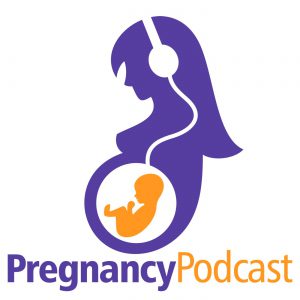
The Pregnancy Podcast – Interventions
Why this podcast?
The Pregnancy Podcast was a huge part of my inspiration for creating this blog.
I loved how I could get evidence-based, well-researched information given in a super relaxed, easy to listen to style in episodes of thirty minutes or less.
Is there much more to say?

How does it look?
There are actually three different styles of episodes.
Forty weeks gives you information about what’s happening with you and your baby in each week of your pregnancy. These episodes are five minutes.
Q&A episodes last between five and ten minutes. A listener’s question is shared and then the host, Vanessa Merten, lays out the research behind her response.
The Pregnancy Podcast episodes tend to be around half an hour, are released each week and have covered subjects such as pregnancy sleep issues, breastfeeding, morning sickness, labour positions, when birth doesn’t go as planned, gestational diabetes, vaccines, breech babies and skin to skin.
Why this episode?
If you give birth in a hospital it is super important to be aware of all the interventions you may encounter. That way you can think ahead of time about which you want and which you might want to delay or avoid altogether.
There are no guarantees of course and birth is unpredictable.
So are people.
You may change your mind but going in with the ability to make really informed decisions is huge.
Who should listen to this episode?
Anyone who is pregnant.
Even if you are planning a home or birth centre birth it’s good to know what interventions you might run into in the event of a hospital transfer.

The episode
At just over twenty minutes and covering seven interventions, this episode is not going to give you a lot of detailed info about each procedure.
It will, however, be a great jumping off point for your own research and give you the basics on the most common interventions.
Where you live may play a role in whether or not you are likely to encounter all of these interventions but I think most will be fairly universal.
Talking of jumping off, shall we?
#1 – Hep-Lock
This is an IV catheter that is put into the back of your hand. It is not connected to an actual IV but if you were to need medication later it would allow this to be given without delay.
This sounds fairly ok but if you are planning a birth without intervention, this might be a small step down a road that you don’t want to go down.
What else might be given through the IV?
Fluids, to keep you hydrated. Whilst this sounds good it can also lead to edema (swelling due to excess fluids) and can cause your baby to have a higher weight at birth.
The problem with that is that once the excess fluid has left your baby’s body it can look like weight rather than fluid loss.
If you are breastfeeding this could lead to pressure to switch to or supplement with, formula.
Drinking enough during labour is the best way to avoid being given fluids in the first place.

#2 – Electronic Fetal Monitoring (EFM)
There are different types of monitors: external, where belts are placed around your abdomen, telemetry units which are on wheels and allow you more freedom of movement and, finally, internal monitors where a small screw is placed into your baby’s scalp.
As long as you are low-risk there should be no reason why you cannot be monitored intermittently.
However, even low-risk women will be monitored continuously if they receive Pitocin or an epidural.
Interestingly, the use of continuous EFM on low-risk women experiencing normal labour has not been shown to improve birth outcomes.
Instead, it has been shown to increase the rate of cesareans.
Asking to be monitored intermittently, or, in the case of continuous monitoring, with a mobile unit or to be on a chair or birth ball rather than on the bed, could help to keep you more mobile and comfortable during labour.

#3 – Induction
Basically, this is starting labour artificially. If there is no medical reason to do this I, along with Vanessa, would really encourage you to wait until your baby is ready to start labour naturally.
How is labour induced?
Membrane sweeping is where your care provider will use their finger to separate your cervix from the tissue around your baby’s head.
Rupturing of the membranes using a hook to break your bag of waters is another way. This may also be done to speed up labour but studies do not really show that this is effective.
Cervical ripening can be achieved either by inserting a gel containing prostaglandins or inserting a kind of balloon catheter.
Pitocin is the synthetic form of oxytocin (the hormone that causes contractions) and can be administered to induce labour via an IV. Pitocin can have quite a few side effects including longer and stronger contractions which can be harder to handle, both for you and your baby.
If induction is definitely the route you plan to go down it could be worth trying some more natural ways of kick starting labour first.

#4 – Epidural
Vanessa points out that this is not generally seen as an intervention but maybe it should be.
Medication will be delivered through a catheter inserted into your back.
Pros – It’s usually effective at relieving pain and the amount of medication you are getting can be adjusted. You remain alert and aware but can rest or maybe even sleep and stock up on energy for the birth itself.
Cons – Due to loss of sensation in your legs you may be unable to stand or even move very much at all. Even if you can feel your legs, continuous EFM, an IV and possibly a catheter, mean that your mobility will definitely be limited. The pushing stage of labour can also be longer with an epidural due to the loss of feeling.
For a more in-depth look at epidurals please check out this post (also featuring The Pregnancy Podcast).
#5 – Episiotomy
This is a cut made to widen your vaginal opening and would be given during the pushing stage of labour.
For a long time, it was thought an episiotomy would heal better than a tear and that giving an episiotomy could prevent a more serious tear.
Research now suggests that actually, natural tears heal better and that a cut can be more extensive than a tear would have been. A tear could extend an episiotomy (think of making a cut in a piece of material and then ripping….) and end up being worse than a tear would have been.
An episiotomy can speed up the process of your baby being born and may be recommended if your baby is distressed or if there is a need for forceps or a ventouse suction cup.
To try and avoid both a tear and an episiotomy you could try doing pelvic floor exercises and perennial massage during pregnancy as well as following your body’s natural urge to push during birth itself.

#6 – Assisted delivery
This is when forceps or a ventouse suction cup are used to help the birth of your baby.
A ventouse is less likely to do serious damage to your perinium but may be less effective at helping your baby be born.
Forceps are more effective but can cause redness or slight bruising on your baby’s face. An episiotomy is almost always given if forceps are going to be used and you could also experience a serious tear.
#7 – Cesarean
The biggest of all the interventions, in an emergency this procedure can be life-saving. However, many c-sections are given for non-emergency reasons.
The recovery time from a c-section is generally longer than from a vaginal birth and there is a whole list of things that your baby could miss out on in the event of a c-section (getting liquid squeezed out of their lungs as they travel down the birth canal, the symphony of hormones between them and you..).
Again, in an emergency, thank goodness for this kind of surgery, but if it is not necessary it is probably best avoided.
Making informed decisions, knowing that one intervention can often lead to a cascade of interventions and the presence of a doula can all help lower your chances of having a cesarean.
To wrap up
This episode really just scratches the surface of all the information that is out there about interventions, why and when they might be used and their risks and benefits.
But, at just over twenty minutes, it’s a very accessible way to start thinking about which interventions you are ok with and which you would like to avoid.
Going into your birth with enough knowledge will enable you to make truly informed decisions and be an active participant in your birth.
Vanessa has actually written a book, Your Birth Plan, and I think it’s fantastic.
Not only are there birth plan ideas for home, birth centre and hospital births but each intervention and procedure is covered in detail and there are even plan Bs in case things do not go the way you expect.
I don’t really do adverts on this blog but this book is such a useful one and is totally inexpensive. It can be bought as a hard copy, an e-book or even as a PDF at a significant discount. Check it out and let me know what you think!
Similar episodes on this topic
Birthful – ACOG’s New Recommendations on Limiting Interventions
The Boob Group – Birth Interventions: The Impact on Breastfeeding
Natural Birth and Baby Care – Getting Daddy Ready for Labor & Birth
Emily Wills is a doula based in Stockholm. She believes that birth can be a beautiful and empowering experience and started this blog as a way of sharing some really great podcasts. She is also a mother of three and an enthusiastic runner.
